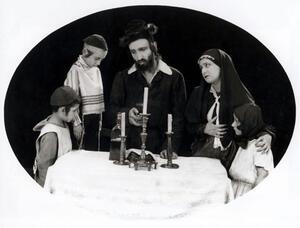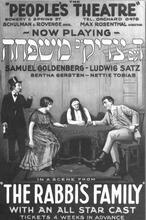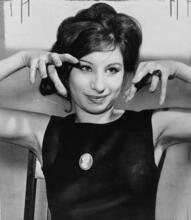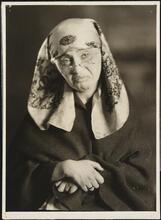Yiddish Film in the United States
Courtesy of the American Jewish Historical Society.
American Yiddish films captured the language, lifestyle, values, dreams, and myths of Yiddish culture, creating a haven for immigrant communities in New York City. Emerging in the early twentieth century, Yiddish film reached its “Golden Age” between 1936 and 1939, when more than two dozen films opened. Women played a significant role in Yiddish films, both as actors and characters depicted on screen. The most prevalent image of Jewish women to be presented in Yiddish films is the immigrant woman struggling to overcome the adversities. Celia Adler, Jennie Goldstein, Lili Liliana, and Berta Gersten were just a few of the women who became influential actors on the Yiddish screen. The height of Yiddish film was curtailed abruptly by the onset of World War II.
The Emergence of Yiddish Film
During the early half of the twentieth century, feature films in the Yiddish language were produced in and around New York City. A direct offshoot of the Yiddish theater, these films, as well as those produced in Poland, Russia, and Austria, ranged from farce and musical comedy to melodrama and tragedy. The films presented an unusual body of ethnic images and were produced, financed, and directed by a handful of male entrepreneurs hoping to capitalize on the burgeoning film industry. During the “Golden Age” of Yiddish film, 1936 to 1939, more than two dozen films opened in New York City to encourage box-office income, only to be curtailed abruptly by the onset of World War II. The films capture the language and lifestyle, as well as the values, dreams, and myths, of the world of Yiddish culture and immortalize some of the greats of the Yiddish theater.
The films follow by several decades the height of the thriving Yiddish theater that played such a significant role in the life and culture of the immigrant communities. The earliest films produced after World War I and in the 1920s have not survived, and written reports are notoriously inaccurate, so it is difficult to secure any definitive information. The first surviving film, East and West (1923) was actually filmed in Vienna; it starred Molly Picon and was produced by an American filmmaker, Sidney Goldin, together with Picon and her husband, Jacob Kalich. The film is a hilarious depiction of a young American secularized Jewish woman in conflict with the traditions of her European Jewish family she is visiting. The film provides a marvelous vehicle for the impish comedian to cross-dress, satirize parochial religious practices, and strut her way into a new medium. Picon later re-created similar characterizations of the independent, feisty, secular young Jewish woman in Yiddle with His Fiddle (1936) and Mamele (1938).
Women in Yiddish Films
The most prevalent image of Jewish women to be presented in American Yiddish films is that of the immigrant woman struggling to overcome the adversities of the difficult immigrant experience: Judith Abarbanel in Uncle Moses, Lucy Levin in His Wife’s Lover, Jennie Goldstein in Two Sisters, Yetta Zwerling in Motl the Operator, and Celia Adler in Where Is My Child? All these roles attracted large audiences and were immensely popular, especially among immigrants in the large metropolitan areas.
Only a few women were involved in the behind-the-scenes creation of films. Sheyne Rokhi Simkoff wrote His Wife’s Lover (based on Molnar’s The Guardsman, a 1931 Academy Award–winning feature film with Lunt and Fontanne). This first Yiddish talkie opened September 25, 1931, at the Clinton Theatre on the Lower East Side to favorable reviews in the Yiddish and English press. Shirley Castle Alexander (Ulmer) wrote the screenplay for American Schadchen and also assisted her husband, Edgar G. Ulmer, with his four Yiddish film productions. Judith Berg was the choreographer and featured performer in the dance of death sequence for The Dybbuk, and Molly Picon and Jacob Kalich were co-producers of Picon’s 1923 film shot in Vienna, Mizrakh un Mayrev (East and West).
Women were the stars of many of the Yiddish features: Berta Gersten as Mirele Efros; Celia Adler, doyenne of the Yiddish stage, as the bereaved mother in Where Is My Child? (1937); Miriam Riselle as the rebellious daughter Chava in Tevye (1939); Lili Liliana as the beautiful, ethereal Leah in The Dybbuk; Jennie Goldstein as the long-suffering, sacrificing sister in Two Sisters; Helen Beverley in Green Fields and The Light Ahead; Judith Abarbanel in Uncle Moses and Americaner Schadchen; and Florence Weiss in The Singing Blacksmith. Yetta Zwerling, a marvelous comedian from the vaudeville stage, starred in eight Yiddish features. One genuine Hollywood star, Lila Lee, who starred with Rudolph Valentino in Blood and Sand (1922), returned to the East in 1926 to make Broken Hearts with Maurice Schwartz. Otherwise, female roles were drawn from the cadre of talent available in the Yiddish theater in the New York area.
A few of the stars tried to cross over to the American film scene in Hollywood, but other than Molly Picon (Come Blow Your Horn, 1963, and Fiddler on the Roof, 1971), most of the women featured in Yiddish films remain relatively unknown beyond the world of Yiddish theater. A few exceptions are Reizl Bozyk, who played the grandmother in Crossing Delancey, Helen Beverly, who performed on stage and screen (The Master Race and The Robe); Berta Gersten, who appeared in The Benny Goodman Story (1956) and A Majority of One (1959); and Dina Halpern, who performed on stage frequently in the Chicago area.
Selected Yiddish Actors and Films
Prepared by Miriam Saul Krant
Abarbanel, Judith
Uncle Moses, 1932; The Cantor’s Son, 1937; Americaner Schadchen, 1940.
Adler, Celia
Where Is My Child, 1937.
Appel, Anna
Broken Hearts, 1926; The Eternal Prayer, 1929; The Holy Oath, 1937; Green Fields, 1937; The Singing Blacksmith, 1938.
Beverly, Helen
The Cantor’s Son, 1937; Green Fields, 1937; The Light Ahead, 1939; Overture to Glory, 1940.
Drute, Dina
Green Fields, 1937.
Gersten, Berta
Mirele Efros, 1939; God, Man and Devil, 1949.
Goldstein, Jennie
Two Sisters, 1938.
Halpern, Dina
The Dybbuk, 1937; The Vow, 1938.
Kressyn, Miriam
Sailor’s Sweetheart, 1930; Purimsphiler, 1937.
Liliana, Lili
The Dybbuk, 1937; Kol Nidre, 1939; Mazel Tov Yidden, 1941.
Picon, Molly
Das Judenmadel [The Jewish Girl], 1921; East and West, 1923; Yiddle with His Fiddle, 1936; Mamele, 1938.
Riselle, Miriam
Tevye, 1939; The Singing Blacksmith, 1938.
Weintraub, Rebecca
Tevye, 1939.
Weiss, Florence
The Cantor’s Son, 1937; The Singing Blacksmith, 1938; Overture to Glory, 1940.
Zwerling, Yetta
I Want to Be a Mother, 1937; I Want to Be a Boarder, 1937; Living Orphan, 1939; Kol Nidre, 1939; The Great Advisor, 1940; Motl the Operator, 1940; Jewish Melody, 1940; Her Second Mother, 1941; Mazel Tov Yidden, 1941
Hoberman, J. Bridge of Light: Yiddish Film Between Two Worlds (1995).
National Center for Jewish Film. Films, videotapes and files. Brandeis University, Waltham, Mass.












